
Root Vegetable Stew
This is hearty winter stew made from root vegetables that don't seem to get much play time in the modern American kitchen. It has a beautiful red color, like borscht, but a complex vegetable flavor.
Ingredients
- 8 oz beets with greens
- 1 t black pepper
- 6 oz carrots
- 1 fennel root with greens
- 4 cloves garlic
- ¼ c olive oil
- 6 oz parsnips
- 2 T olive oil
- 6 oz potatoes fingerlings
- 1 bell peppers red
- ½ t rosemary
- 8 oz rutabagas
- 1 t kosher salt
- 1 t savory
- 2 cloves shallots large
- 2 qt stock vegetarian
- 1 t thyme
- 8 oz turnips
Herbes de Provence
- 2 units basil
- 5 units marjoram leaves
- 2 units rosemary leaves
- 1 unit sage
- 2 units kosher salt
- 5 units savory
- 5 units thyme
Instructions
Preparation
- Assemble your ingredients. Wash and pat dry your root vegetables; they do not require peeling for this dish.
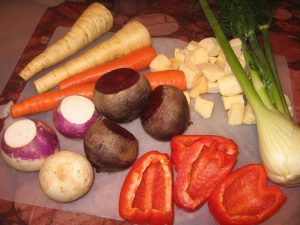
- Top the beets and fennel root and coarsely chop the tops. Peel and dice the shallots. Grate the garlic. Set these ingredients aside for your sweat.
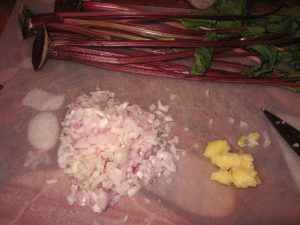
- Cut the washed root vegetables into rough pieces, with nothing much larger than a ½" cube. Seed and dice the red bell pepper.
Cooking the Roots
- Put ¼c olive oil in a large bowl and add the herbes de Provence spice mixture, mixing well. For the purposes of this recipe, each unit of spice in the ingredients list should be a teaspoon, which yields a shy ½c of herbes de Provence. This traditional Provençal spice mixture is good with any kind of hearty fish or meat dish. Use whole-leaf spices when available. If you have fresh lavender from your garden, 2 units can also go in this mixture.
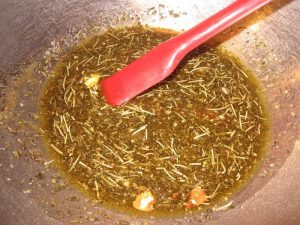
- Add the bell pepper and all the root vegetables to the bowl and toss or mix them well to get them all thoroughly coated with the spiced oil.
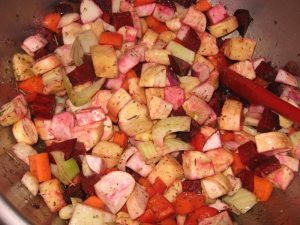
- Spoon a layer of the oiled vegetables onto 2 baking sheets; the amount of vegetables this recipe calls for should cover about 1½ sheets. Use baking sheets with a raised lip to contain the vegetables. Put the baking sheets in a preheated 350°F oven for 1h.
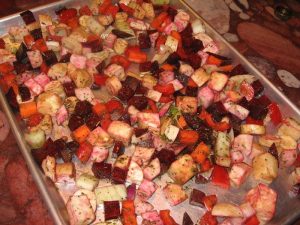
- After 30m, quickly turn the vegetables once with a spatula.
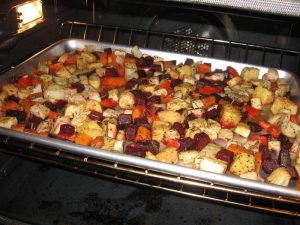
Cooking the Stock
- Just before it is time to turn the root vegetables in the oven, begin with the stock. Put 2T olive oil in a large stock pot and add the garlic and shallots. Sweat them over medium heat until the shallots are soft and translucent.
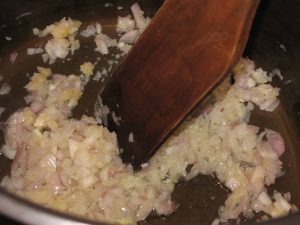
- Pour in your stock. For the pictured recipe I used turkey stock we made after Thanksgiving; chicken stock or vegetable stock are other possibilities. Add the chopped beet tops and and fennel tops along with 1t black pepper, ½t rosemary, 1t kosher salt, 1t savory, and 1t thyme. Bring the stock to a boil and then reduce the heat to keep it at a high simmer until the root vegetables are done.
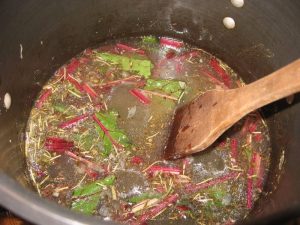
Finishing
- Add about ⅔ the root vegetables to the pot and hit it with an immersion blender until it reaches a smooth consistency. At this time, if you think the stew is going to be too thick, you can thin it with a little extra stock.

- Once it is well-blended, add the remaining root vegetables for texture. Simmer for another 20m or so before service.
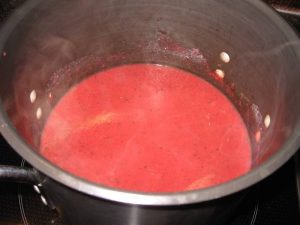
Notes
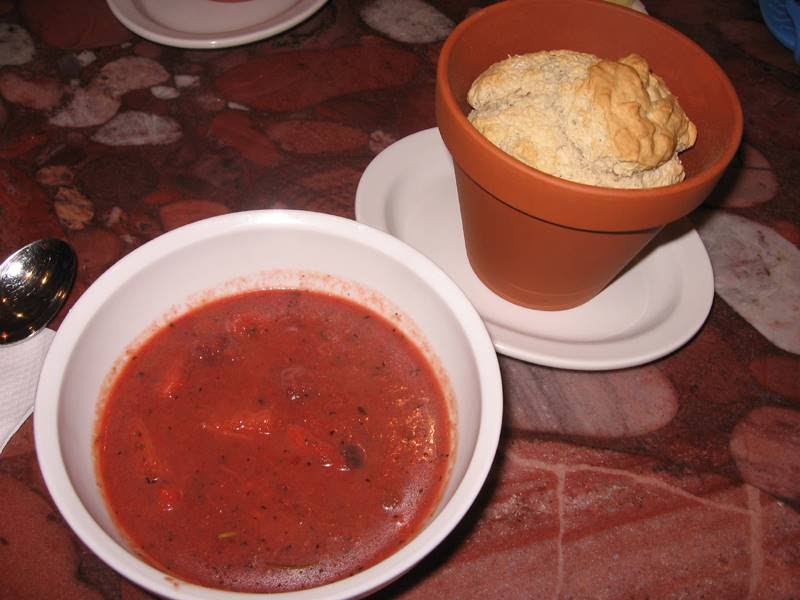 Serve this stew with an easy home-made bread or rolls.
Proportions in a recipe like this can be very seat-of-your-pants. Different ratios or substitutions of root vegetables won't kill the finished product, although the beets and red bell pepper are important for the coloration, and a sufficient amount of hard root vegetables (beets, parsnips, rutabagas, turnips) are necessary for a good final texture. Burdock, daikon, or salsify would probably be fine in here; I wouldn't recommend jicama, sweet potato, or taro.
When I was photographing this recipe I totally spaced on the bag of fingerling potatoes I had. No worries -- instead of roasting them, I threw them in when I was cooking the stock. By the time the other roots came out of the oven they were done; I pulled half of them out with tongs to reserve for texture before throwing in roots for blending.
When it comes to potatoes for this stew, I really recommend small potatoes (so you can leave the whole of halved), and moreover potatoes that are hard and waxy (as opposed to fluffy or mealy) -- baking potatoes are a poor choice for this stew, as they won't hold their body.
Serve this stew with an easy home-made bread or rolls.
Proportions in a recipe like this can be very seat-of-your-pants. Different ratios or substitutions of root vegetables won't kill the finished product, although the beets and red bell pepper are important for the coloration, and a sufficient amount of hard root vegetables (beets, parsnips, rutabagas, turnips) are necessary for a good final texture. Burdock, daikon, or salsify would probably be fine in here; I wouldn't recommend jicama, sweet potato, or taro.
When I was photographing this recipe I totally spaced on the bag of fingerling potatoes I had. No worries -- instead of roasting them, I threw them in when I was cooking the stock. By the time the other roots came out of the oven they were done; I pulled half of them out with tongs to reserve for texture before throwing in roots for blending.
When it comes to potatoes for this stew, I really recommend small potatoes (so you can leave the whole of halved), and moreover potatoes that are hard and waxy (as opposed to fluffy or mealy) -- baking potatoes are a poor choice for this stew, as they won't hold their body.